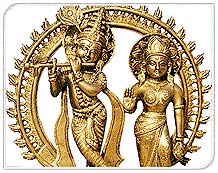 The
city of Mathura, in Uttar Pradesh, the nucleus of Brajbhoomi, is located at
a distance of 145 km south-east of Delhi and 58 km north-west of Agra. Covering
an area of about 3,800 sq. km., today, Brajbhoomi can be divided into two distinct
units - the eastern part in the trans-Yamuna tract with places like Gokul, Mahavan,
Baldeo, Mat and Bajna and the western side of the Yamuna covering the Mathura
region that encompasses Vrindavan, Govardhan, Kusum Sarovar, Barsana and Nandgaon.
The
city of Mathura, in Uttar Pradesh, the nucleus of Brajbhoomi, is located at
a distance of 145 km south-east of Delhi and 58 km north-west of Agra. Covering
an area of about 3,800 sq. km., today, Brajbhoomi can be divided into two distinct
units - the eastern part in the trans-Yamuna tract with places like Gokul, Mahavan,
Baldeo, Mat and Bajna and the western side of the Yamuna covering the Mathura
region that encompasses Vrindavan, Govardhan, Kusum Sarovar, Barsana and Nandgaon.